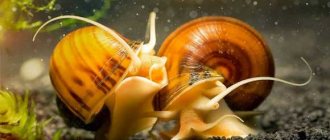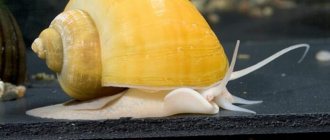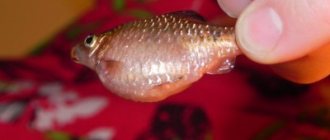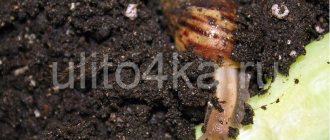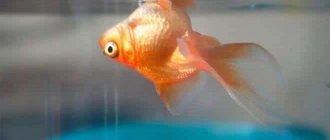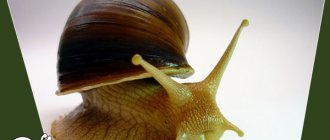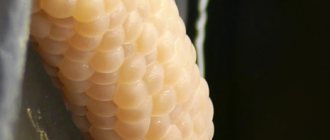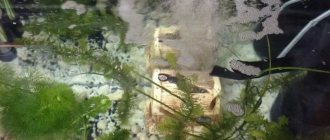Snails in an aquarium
Quite often, novice aquarists in the process of arranging an aquarium think about whether snails are needed in the aquarium. To solve this issue, you need to know why they are allowed into the aquarium in the first place and what is the benefit of it.
Do you need snails in an aquarium?
These little inhabitants can bring both benefit and damage to your aquarium. Here, as in the case of drugs, everything depends on the dose. Snails are natural orderlies. They eat all leftover food and dead plants. In addition, snails are used to clean the aquarium; they remove plaque from the walls and absorb fish waste products. There are some species of snails that you can safely use as indicators of water quality in your aquarium. And small snails in an aquarium often serve as a decorative element.
But these creatures reproduce very quickly, so over time you will have to artificially regulate their population. If there are too many snails in the aquarium, this will lead to a lack of oxygen. If there is a lack of food, they will begin to eat plants, and some species secrete mucus, which will lead to contamination of the aquarium.
There are several ways to get rid of an overgrown snail population. It is enough to simply manually catch and remove excess individuals. Experienced experts recommend a simpler method. Place a saucer with bait on the bottom of the aquarium. When the snails gather in it, simply remove the saucer from the aquarium. In addition, the pet store will offer you special means to combat snails, which will greatly simplify solving the problem.
What do snails eat in an aquarium?
Under natural conditions, snails eat algae and bacterial growths. In an aquarium, snails can eat gray films on glass and algae leaves. Apple snails are great at scraping off all the plaque from glass and plants. They can also eat young plants, but this happens very rarely and due to lack of food.
As a rule, snails feed on dead algae and this helps maintain water quality at the desired level. Apple snails can eat almost anything that they can grind and swallow. Here is a basic list of what snails eat in an aquarium: spinach, cucumbers, carrots, fish food. Snails can also eat dead fish and their eggs. The food should be fairly soft. You can offer them scalded, scraped meat or boiled lettuce. Throw in a few pieces of soaked white bread.
To develop and build a house, snails need calcium. Make sure that the pH of the water does not fall below 7; if it is higher, it will only be beneficial. If the water in the aquarium is too soft, then crushed marble and limestone should be added to it. You can grind sea shells or buy preparations specially designed for this at a pet store. They increase the hardness of the water in the aquarium.
Where do the snails come from in the aquarium?
It happens that snails suddenly appeared in the aquarium when you had absolutely no plans to have them. The snail could have come from
soil or plants. If you did not boil the soil before pouring it into the aquarium, then there could very well be a shell with a snail in it. Often, snails in an aquarium appear as eggs on algae leaves.
Why do snails die in an aquarium?
There are only two reasons for the death of snails. Too soft water and lack of food lead to such sad consequences. Periodically feed your pets with boiled cabbage or salad. This will not spoil the water, but will give the snails a chance to get enough. Please note that apple apples require about 10 liters per individual. Always carefully monitor the water hardness and then problems will not arise.
WomanAdvice.ru>
Necessary conditions for successful reproduction
Ampularia are considered very unpretentious snails, but in unfavorable conditions they will not reproduce.
Feeding
- all food for fish, but it is most convenient to offer them food for catfish, since it sinks to the bottom, from where it will be convenient for the mollusks to pick it up;
- aquarium plants, especially if there is a lack of spirulina in their diet;
- love vegetables very much;
- they eat up the remaining organic matter from the walls and bottom of the aquarium;
- eat the corpses of dead fish.
Important! If the snails live in the same aquarium with fish, and you feed all the inhabitants with the same food, the snails may well starve: they will get too little food.
When it comes to vegetables, keep the following in mind:
- vegetables that snails cannot scrape with their mouths, for example, cabbage or bell peppers, need to be lightly boiled, but they can easily eat soft vegetables like zucchini or cucumber raw;
- the remains of uneaten vegetables should be removed from the aquarium, otherwise the water will become rotten and become unsuitable for life.
Find out what types of aquarium snails there are.
Water
The gap between the water level and the edge of the aquarium is at least 10 centimeters, and the aquarium must be covered with a fairly heavy lid, preferably glass, so that the females, in search of a convenient place for laying, do not fall out and die.
Did you know? Snails are much smarter than you might think. Due to the fact that their brain is made up of four sections, they are able to carry out thought processes and make decisions based on life experiences.
Regular filtration of water and saturation with oxygen is also required, at least twice a day for 15 minutes.
The water parameters can be anything - any water except sea water is suitable for ampularia. The only condition is that it should not be too soft, otherwise your snails’ shell will begin to deteriorate and become damaged.
Everything you wanted to know about ampullaria snails...
Ampularia (lat. Pomacea bridgesii) is a large, bright and popular aquarium snail. It is not difficult to maintain, but there are important details in feeding. Originally from the Amazon, where it lives throughout its entire length, it has eventually spread to Hawaii, Southeast Asia and even Florida.
In nature, ampullaria spend most of their lives in water, emerging only by chance and during reproduction to lay eggs. And yet, although they spend most of their lives underwater, they need atmospheric oxygen to breathe, for which they rise to the surface.
You can often observe how an ampoule in an aquarium rises to the surface, extends its breathing tube and begins to pump oxygen into itself. Its respiratory system is comparable to the lungs of a fish, having gills (on the right side of its body) and lungs on the left side.
Aquarium ampullaria snails have adapted very well to life in the tropics, where dry periods alternate with the rainy season. This was reflected in their body, they developed a muscular leg with a protective flap attached to it. With the help of this valve, they close their shell to survive in the remaining water and dirt during the dry period.
They live in all types of reservoirs, in ponds, lakes, rivers, canals. Despite the fact that many snails are hermaphrodites, ampullaria are heterosexual and require a partner to reproduce.
Although the most common color is yellow, they still come in many different colors. In addition to yellow ampoule, you can find white, brown and even almost black. Nowadays blue ampularia have become fashionable, but they are not particularly different from yellow ones in maintenance and breeding. When you buy one, it is important to remember that it grows much larger than other snails. They are sold quite small, up to 2.5 cm in diameter, but they can grow to a size of 8-10 cm. There are also larger ones that are very well fed, and they become so large that they can compete in size with other giants - marise snails.
The aquarium contains several different types of ampularia, which differ from each other in the shape of the shell. The lifespan of ampularia in an aquarium is 2 years.
Keeping ampularia in an aquarium
If kept alone, a very small aquarium, about 40 liters, will be enough for them. Since snails eat aquarium ampularia, they eat a lot, and there is also a lot of waste after them, it would be correct to allocate at least 10-12 liters of volume per one. Considering that they reproduce quite vigorously, it is not worth keeping them much.
But, since ampullaria themselves are rarely kept in the aquarium, it is better to count on a larger aquarium volume. So, for 3-4 snails + fish, you need about 100 liters. Of course, a lot depends on your conditions and details. But as a rule, 10 liters per ampoule will not let you down.
Yellow ampullaria are completely peaceful and never bother fish or invertebrates. There is a misconception that they attack fish. But this is due to the fact that snails are scavengers and eat dead fish, but it seems they killed the fish. Not a single snail is capable of catching up, catching and killing a healthy and active fish.
But ampularia fish are very disturbing. They can tear off their antennae, such as the Sumatran barbs, or even completely destroy them, such as dwarf tetradon, fahaka, green tetradon, clown botia or large cichlids. Some will not be able to eat large snails, but they will clean up small ones. And they will gnaw large ones at every opportunity, which will not improve their health either. Invertebrates such as shrimp and crayfish can also become a problem; they expertly pick snails out of their shells and eat them.
Organs of vision and breathing
Feeding
What to feed aquarium ampularia? It's very simple, they eat almost any type of food. In addition to the fact that they will eat all types of food that you give them, they will also eat everything that they can find in the aquarium. The advantage is that they finish the food after other inhabitants, preventing them from rotting and spoiling the water.
The easiest way to feed ampularia is with catfish tablets and vegetables. They especially love cucumber, zucchini, lettuce, even pumpkin. Two conditions must be observed - boil the vegetables for a couple of minutes and do not keep them in the aquarium for more than a day, as the water becomes very cloudy.
They also eat live food with pleasure; I have had them eat bloodworms and tubifex. But here they need to be able to get to it, that is, a clean bottom, and in a general aquarium, as a rule, the food has time to fall into the ground. But remember that ampullaria easily damage young leaves of plants and tender species, eating them up to the trunk. To prevent this from happening, you need to feed them plenty of vegetables and food containing spirulina.
Breeding ampularia
How do ampullaria reproduce? Unlike many aquarium snails, they are not hermaphrodites and you need a male and female for successful breeding. The easiest way to get such a pair is to buy 6 snails at once, which practically guarantees individuals of different sexes. When they become sexually mature, they will begin to breed on their own; no action needs to be taken to stimulate them. How to understand that this happened? During mating, the male and female merge with each other, with the male always on top.
After mating is complete, the female climbs out of the water and lays a large number of eggs above the surface of the water. The caviar is pale pink in color and should be above the surface of the water, without plunging into it, otherwise it will simply disappear. The surface of the caviar calcifies under the influence of air and the babies are completely safe.
The small snails hatch after a few weeks, provided the ambient temperature is 21-27C and there is sufficient humidity. Newborns are quite large, fully formed and do not require any special care.
Ampoule caviar
Most popular questions:
Ampularia laid eggs. What to do?
If you are not worried about the snails getting into the general aquarium, then...nothing. At constant humidity and temperature, the caviar or eggs of the ampoule will hatch on their own, fall into the water and begin a completely independent life. Catching them is not a problem, but if you want, you can place an incubator made of a plastic bottle under the clutch. Small snails will fall there and you can transfer them to the general aquarium.
The moment the babies emerge from the eggs:
The ampularia has not moved for a couple of days, what happened?
Most likely she died if she did not move for several days. An easy way to understand this is to take out a snail and smell it. But be careful, the smell can be very strong. Dead ampullaria snails in the aquarium must be removed, as they decompose very quickly and can spoil the water.
I want to give vegetables, but they float. What should I do?
It’s very simple, just prick a piece with a fork or any stainless steel object.
Do ampularia spoil plants?
Yes, some species can, especially if they are hungry. How to fight? Feed them enough.
I want to start an ampoule, but I’m afraid that they will get divorced. How to control them?
This is not a problem at all. Firstly, the caviar is large and above the water, it is very difficult not to notice it. Secondly, the snails themselves are large and easy to catch even with your hands. Well, you can find other ways to get rid of snails in the link.
Is it necessary to somehow create a place where they can lay eggs?
It is enough that the aquarium is covered. The space between the lid and the water creates ideal conditions for caviar. And yes, it’s better to cover, as ampullaria can crawl away on the journey.
My snail is already very big, how long will it continue to grow?
With good feeding, the Pomacea maculata species can reach 15 cm in diameter. But, as a rule, they are 5-8 cm in diameter.
Part of my ampullaria’s body was torn off, what should I do?
Nothing, they have a wonderful ability to regenerate. Typically, a lost organ will grow back within 25 days. It may be slightly smaller in size, but it is fully functional. They even restore eyes.
How do ampoules tolerate salt water?
If you gradually increase the concentration, they can withstand slight salinity. If the snail stops crawling out of the shell when you increase it, then reduce it before it’s too late.
Do ampullaria carry parasites?
Yes, there are several species for which they are carriers. However, ampularia resist quite well, and are much more resilient than parasites. There is one parasite that poses a danger to humans (the nematode Angiostrongylus cantonensis). Its main carrier is the rat, and a person can become infected if he eats raw snails. In rare cases, it causes damage to the nervous system and even death. But, you have absolutely nothing to fear. Ampoules can only become infected with it if they live in nature, where their neighbors are infected rodents. It is difficult to imagine that local aquarium-bred ampullaria can come into contact with them. But even so, you will still need to eat a raw snail.
Do apple snails hibernate?
Yes, during the dry season in nature, some species can. But in an aquarium they don’t need this.
My ampoule shells are not the same color in some places, what's the matter?
This is due to the fact that at some point they stopped growing (change of habitat, lack of food, different water) and as soon as everything got better, they immediately restored the former quality of the shell. But the trace remained. It's okay, the main thing is that you continue to keep them well.
The shell of my ampularia is collapsing. Why is this?
To form shells, snails absorb calcium from the water. If you have very old or very soft water, then it may simply not be enough. And her defense, her shell, cracks. It’s not difficult to fix this; at least replace some of the water with fresh water or add minerals to make the water harder. But keep in mind that they can repair holes in the sink, but sometimes the tip of the sink disappears and they cannot restore it. However, this does not particularly interfere with their lives.
I found an empty ampoule shell. Did someone eat her?
Most likely she died herself. The types of fish that can eat them are already listed above. But if it dies on its own, it decomposes very quickly, since it consists entirely of protein.
How long do ampularia live?
Highly depends on the conditions of detention and temperature. At low temperatures up to 3 years, and at temperatures from 25°C only 12-16 months. At higher temperatures, ampularia are more active, grow and reproduce faster. But the side effect is accelerated metabolism, and, accordingly, early death. The temperature for keeping ampularia can vary between 18 - 28°C
Will ampularia survive in a pond?
During the summer it is quite possible, as they can live at temperatures of 18-28°C. But in the fall, you understand...
My ampullaries are not active, they often lie and do not move. I feed normally, the conditions are good.
If they haven’t died (see how to check above), then everything is fine. Snails themselves are rather lazy creatures; they have only two desires: either to eat or to reproduce. Accordingly, when these desires are absent, they simply sleep. Or your water temperature is low, as we have already written about above.
My ampularia has surfaced and is floating on the surface. Is she dead?
Not necessary. As mentioned above, they are quite lazy, and since they breathe air that they pump under the sink, they can easily float to the surface. It's very easy to check what's wrong with her. Take it out of the water and see if the snail quickly closes the shell, then everything is fine with it. The deceased's muscles relax and she does not move.
How long does it take for the ampularia eggs to hatch?
Two to four weeks, depending on temperature and humidity.
Do ampullaria reproduce throughout the year?
Yes, but much less in winter.
Why did the ampularia die?
It’s difficult to say for sure, there could be many reasons. But, as a rule, in community aquariums they die... from hunger. This is a large snail, in order to live and grow it needs a lot of food, and in a general aquarium it does not have enough of it.
Can ampularia live without water?
Of course not, it's a water snail. If you see her crawling out of the water or even crawling out of the aquarium, this means that the female is looking for a place to lay her eggs. In this case, you need to close her exits from it, otherwise she will crawl out and die. For caviar, you need a place with high temperature and humidity, usually the ideal place is under an aquarium lid or glass.
Does the ampoule eat fish?
As we have already said, only dead. She has neither speed nor teeth for hunting fish. But she eats dead fish with pleasure.
Is the ampularia buried in the ground?
No, she is too big, she would need the efforts of a small bulldozer.
Is it possible to keep apple turtles and red-eared turtles?
Yes, ampularia is an excellent food for red-eared turtles. Joke. No, the reason has already been given.
Do ampoules and helenas get along?
Adults, yes. For Helen, adult ampularia is clearly too much for her, but they can eat small ones.
catfishes.ru>
How to get rid
Before starting the gastropod control process, you should clean the aquarium. This is necessary in order to get rid of eggs deposited in algae, as well as in tank decorative items. During the cleaning operation, the inhabitants of the aquarium should be moved to another container. Simply catching the gastropods from the tank will not be enough, since the offspring remain in the form of eggs. If they are not removed, fighting snails will be pointless. There are several ways to get rid of snails. Each of them has a number of advantages and disadvantages. Among the main methods are control using chemical, mechanical, and biological control agents. The method using traps also shows good results.
Biological control agents
The essence of this method is the introduction of direct enemies of gastropods - crustaceans or fish - into the aquarium. They eat shellfish.
To remove coil snails you will need to purchase predators. The Helena snail helps a lot. She eats her own kind, but much smaller in size. For fish, this type of predator is absolutely harmless, since they only eat their own kind and insects.
An excellent way to get rid of aquarium snails is to introduce some types of fish that feed on gastropods into the tank. This task is accomplished by:
- Cichlids.
- Gourami.
- Tetradons (for example, dwarf tetradon).
The latter are the most progressive, since they have strong bone plates in place of teeth. With their help, the fish can easily bite through the shell of gastropods. They are aggressive fish and at the time of hatching the mollusks, the remaining inhabitants should be moved to another aquarium.
Macrobrachium (one of the representatives of arthropods) also copes well with the destruction of gastropods.
Chemicals
It is the most effective method in the fight against gastropods, but has a number of nuances. The products contain copper, which is toxic to them. Manufacturers claim that it does not have a negative effect on other inhabitants of the aquarium, but it is better to play it safe and temporarily move the fish into a separate container.
One of the effective remedies against snails is the chemical drug “Thunderstorm”. You can buy it at any pet store. It should be used only as a last resort, as it quickly kills all snails, which negatively affects the biological balance of the aquarium.
You can make your own chemical if for some reason it is not available in the pet store. To do this you will need copper sulfate.
- To begin, move the inhabitants and plants into a separate aquarium.
- Next, you need to dilute 0.4 grams of copper sulfate per 10 liters of water.
- Turn on aeration in the aquarium.
- After several hours, remove the dead snails, clean the tank and change the water.
Mechanical controls
It is the most labor-intensive, since its effectiveness directly depends on human actions. Helps completely remove snails from the aquarium or reduce their numbers to a minimum.
It is necessary to pull out large mollusks from the tank with your hands, and crush small ones against the walls. Removing gastropods in this way is ineffective. If there are plants, their reproduction will continue, since eggs remain on the stems and leaves. To get rid of small shellfish, you need to remove plants and decorative elements from the aquarium. Next, clean them of eggs and gastropods themselves. Small snails in the aquarium may be on air compressor hoses or other equipment, so you should be careful when cleaning.
Traps
It is one of the unusual methods of catching snails. You can buy a trap at a pet store or make it yourself. To do this you will need scissors, a ball, a plastic bottle, several stones, and snail bait.
- You need to take a small bottle.
- Place weight stones and bait on the bottom.
- Place a balloon on the neck of the bottle.
- Using scissors, cut off the top part of the ball so that only a 3-4 cm long tube remains.
- Place the protruding part of the ball in a bottle and fill it with water.
- Lower the device into the aquarium.
Purchased traps are based on the fact that their doors open only into the device. Once there, the snail cannot get back out. Such structures are easy to assemble, but help actively fight gastropods. Store-bought traps are dangerous for fish. Often they swim in there faster than snails, but cannot get out.
Read with this
- Achatina snail: nutrition, reproduction, maintenance, photo
- Achatina snail breeding at home
- Helena snail: benefits, harm and content recommendations
- Maintenance and reproduction of the Neretina snail
- How long do snails live?
- What and how to feed Achatina snails at home?
- All about Achatina snails at home
- Terrarium for Achatina snails: choosing the best
- =symptoms of fish disease=
- 8 popular types of Achatina for home keeping
Ampoules in the aquarium
Ampullaria snails were brought to Europe in the last century from South America. In nature, they live in stagnant water of ponds, swamps or slow-flowing rivers. Snail shells are light or dark brown in color, and yellow ones are especially popular. When danger arises, the snail hides in its shell, which is closed with a horny cap. The ampularia has a very well developed sense of smell; it instantly senses the smell of food and crawls towards it surprisingly quickly. Let's find out whether ampullaria are needed in the aquarium, and what are the benefits of them.
These snails are completely unpretentious, so keeping ampularia in a community aquarium with other inhabitants is quite possible. However, we must remember that if there is a need to treat the fish, then at this time the ampularia should be placed in another container, since medicines for fish can kill the snails. Ampoules loosen the soil, clean the walls of the aquarium from unnecessary algae, and eat food uneaten by the fish.
Reproduction of ampularia in an aquarium
If you want to get offspring from snails, it is better to keep 3-4 individuals in the aquarium. Reproduction of ampularia in an aquarium occurs in the air. The female crawls above the surface of the water and chooses a place for future laying of eggs. Small soft eggs are glued to the lid of the aquarium. The female moves the eggs into a dense pile and after about a day the clutch becomes solid. It is necessary to ensure that the masonry does not end up close to lighting lamps: from excessive heat, the eggs can dry out and die. After about 2-4 weeks, the eggs will mature and small snails will hatch from them.
Why do ampularia die in an aquarium?
The shells of newly hatched snails are very soft, so the fish in the aquarium eat these small snails. To preserve them, you need to install a net in the aquarium on which the mollusks will fall after hatching. Snails should also be grown in a separate container. After they get stronger and grow, the ampularia can be planted in a common aquarium.
Ampoules can die from lack of food if they accumulate too much in the aquarium. Therefore, it is necessary to regulate the number of snails in the container.
In addition, the snails strive to crawl out of the aquarium, but being outside their usual habitat, the ampularia may die. To prevent this from happening, you need to cover their glass house with a lid.
To answer the question: how long do ampularia live in an aquarium, you need to know what the temperature of the water in the container is. At a water temperature of 23-25°4C, snails can live up to three years. At lower temperatures, ampularia can live up to four years with proper care.
WomanAdvice.ru>
How long do they live?
The lifespan of snails depends primarily on the species and conditions of detention.
In nature, the life span of different mollusks is different and for each species it is:
- for Achatina 7-10 years,
- grape snails 7-8 years old,
- ampularia – up to 4 years,
- coils, melanias, marises – 2-4 years,
- Helen – 2 years,
- Neretin – 1-2 years.
Typically, in captivity, the lifespan of a snail is the same as in its natural habitat. If the conditions are favorable, the mollusk will live a long life; for example, one grape snail lived in captivity for 30 years. And if conditions worsen, then, naturally, the life span of the mollusk is shortened.
But it often happens that these exotic pets die before reaching old age. And there are many reasons for this. Let's figure it out.
What to do if you find a dead fish?
Have you suddenly discovered that a fish has died in your aquarium and don’t know what to do now? We have compiled five tips for you to cope with the death of fish and what to do if this does happen. But remember that even in the most ideal conditions, they still die. Often suddenly, for no apparent reason and very annoying for the owner. Especially if it is a large and beautiful fish, such as cichlids.
Attention! First of all, check how your fish breathe!
Often aquarium fish die because the water parameters have changed. The most destructive effect on them is the low level of oxygen in the water. The characteristic behavior is that most of the fish stand on the surface of the water and swallow air from it. If the situation is not corrected, then after a while they begin to die. At the same time, such situations can occur even among experienced aquarists! The oxygen content of water depends on the temperature of the water (the higher it is, the less oxygen is dissolved), the chemical composition of the water, the bacterial film on the surface of the water, an outbreak of algae or ciliates. You can help with partial water changes, turning on aeration or directing the flow from the filter close to the surface of the water. The fact is that during gas exchange, it is the fluctuations of the water surface that play a decisive role.
1.Take a closer look
Check and count your fish daily at feeding time. Are they all alive? Is everyone healthy? Does everyone have a good appetite? Six neon and three speckled, all in place? If someone is missing, check the corners of the aquarium and lift the lid, maybe it is somewhere up in the plants? But you may not find the fish; it is quite possible that it has died. In this case, stop searching. As a rule, a dead fish still becomes visible; it either floats to the surface or lies on the bottom, the floor is covered with snags, stones, or even ends up in the filter. Inspect the aquarium every day to see if a dead fish has appeared? If found, then...
2.Remove dead fish
Any dead fish, as well as large snails (such as apple snails or marises) should be removed from the aquarium. They rot very quickly in warm water and create soil for the development of bacteria, the water becomes cloudier and begins to stink. This all poisons other fish and leads to their death.
3.Inspect the dead fish
If the fish has not yet decomposed too much, then do not disdain to inspect it. It's unpleasant, but necessary. Are her fins and scales intact? Maybe her neighbors beat her to death? Are your eyes still there and aren’t they cloudy? Is your stomach very swollen like in the picture? Maybe she has an internal infection or was poisoned by something.
4.Test the water
Every time you find a dead fish in your aquarium, you need to check the quality of the water using tests. Very often, the cause of fish death is an increase in the content of harmful substances in the water - ammonia and nitrates. To check them, purchase water tests in advance, preferably drop tests.
Analyze
The test results will show two results: either everything is fine in your aquarium and you should look for the reason elsewhere, or the water is already quite polluted and you need to change it. But, remember that it is better to change no more than 20-25% of the volume of the aquarium, so as not to change the conditions of keeping the fish too dramatically. If everything is in order with the water, then you need to try to determine the cause of the death of the fish. The most common: illness, hunger, overfeeding (especially dry food and bloodworms), long-term stress due to improper living conditions, age, attack by other fish. And a very common reason - and who knows why... Believe me, any aquarist, even one who has kept complex fish for many years, has sudden deaths of his favorite fish. If what happened is an isolated incident, then there is no need to worry - just make sure that new fish do not die. If this happens all the time, then something is clearly wrong. Be sure to contact an experienced aquarist; it’s easy to find now, fortunately there are forums and the Internet.
catfishes.ru>
Tumors
Neoplasms can be spontaneous, malignant or benign. The reasons why they arise include:
- poor quality soil;
- unkempt utilitarian or poor materials from which it is made;
- contaminated feed;
- infections;
- perforators of shells such as sponges, algae.
If the tumor is benign, the mollusk may behave as usual. But if its condition gets worse day by day, and the neoplasm causes discomfort, Achatina refuses to eat and becomes apathetic, then the best option is to freeze it. This will prevent your pet from suffering.
In other cases, you can try to cure the animal with medications such as ointments with propolis, mycoseptin and iodine. You can invite the snail to take chamomile infusion inside.
Simple and systematic, daily actions will help you avoid all of the above. These include:
- caring for the ulitaria, cleaning it and timely replacing the soil;
- maintaining a balance of temperature and humidity;
- selection of nutrition, a well-structured diet and a ban on salty, smoked, sweet foods;
- processing of raw products such as fruits and vegetables, monitoring the expiration date of food.
Why did aquarium snails die? Once again!!
FanAnat Letitbit
Yellow snails are called ampullaria. There can be two reasons for their death - not enough food and very soft water. The snails had to be fed with boiled cabbage (it does not spoil the water in the aquarium) or lettuce. In addition, ampularia require a minimum of 10 liters of water per individual.
As for the caviar, it’s dried up. You can safely throw it away, no one will get out of it. To prevent the eggs from drying out, it was necessary to maintain high humidity and a certain temperature in the aquarium.
If you are going to start an ampoule again in the future, I recommend reading this article. It contains a complete description of these aquarium snails.
Sergey Belsky
We also put ampoules into the aqua, our aqua is 150 liters. there is everything, including wildflowers and plants!!, angelfish, guppies, Asian pike, swordtails, catfish, chanterelles, and for my wife we took a Betta and a CHICKEN FOR HIM!!!. AND KICK!!!! AMPULARIA LIVE EXCELLENT!!!! BUT NOT FOR LONG;;;;; THE FILMS AND THE CHICKEN WILL NOT MOVE AWAY FROM THE SNAILS UNTIL THEY ARE SPEEDED TO DEATH!!!!
Plants and accessories
Decorating a tank with snails allows you to realize numerous creative ideas of the owners. You can decorate the space using a variety of branches, driftwood and cones, combined into unusual compositions. The components must be disinfected if we are talking about objects assembled with one’s own hands, or simply purchased at a specialized store. You can also arrange the tank using beautiful moss - either decorative or forest. Again, the moss that you collect yourself must first be soaked for half a day in cool water, then doused with boiling water and finally placed on top of the ground.
Live variations are likely to be quickly nibbled by Achatina, so for long-term use it is recommended to take artificial versions
When selecting decorative components, it is important to avoid hard and hard objects. Half a coconut would also fit well as decoration.
We must not forget that arranging a “home” is impossible without placing a special bowl with clean water. Since snails prefer to swim in it, the container should be medium-sized and highly stable.
These creatures do not need shelter, so excessive decoration will most likely have a detrimental effect. Among plants, experts recommend choosing succulents that look extremely stylish but do not require any special care. The plants have a hard stem that Achatina cannot break. You can plant lettuce or pre-sprouted wheat grains in the aquarium. Of course, after some time the snails will eat them, but for a certain period of time you will still be able to enjoy the unusual design.
Snail problem.
Viko4ka
There is no need to throw it away. The reason may lie in the composition of the water and in the fish themselves. I can’t say anything normal about the composition of the water. Here's about fish: It depends on what kind of fish. If they are predatory (for example, cichlids), then from my own experience I know that the snail will not live with them. Because when I put a snail (like an ampularia) in an aquarium with cichlids, the cichlids first began to bite off its horns, and then completely killed it. Now the shell lies at the bottom of the aquarium. Conclusion: do not put snails with predatory fish. If the fish are peaceful (guppies, neons, etc.), then the snails may be dying from some kind of trouble in the water. Or anything else. In general, don't get any more snails. It’s better to siphon the soil yourself and clean your eyes.
lunatic
ugh. Snails in general are disgusting. I bought them first. They, like you, left millions of offspring and surfaced! and these snails have filled the entire aquarium! It’s better to take some kind of catfish or sticky fish. they are more efficient. and these snails... I had to kill)
Tags
die ampullaria snails in the aquarium ampullaria risesampularia snails very life ampullaria in Contents of ampullaria aquarium ampullaria they themselves ampullaria aquatic ampullaria you Yellow ampullaria absolutely Snails ampullaria snails aquarium snail. Aquarium snails ampullaria other snails. eat at aquarium slugs that snails are scavengers one snail is not Small snails hatching that snails will fall into the Aquarium For an aquarium in an aquarium, a popular aquarium snail is popular. ampularia in the aquarium Aquarium snails in the aquarium snails are kept in the aquarium, aquarium ampullaria are kept in the aquarium snails are picked out from dead ampullaria snails
algaeenough articlesmellplantsfishfemale eatreproductioninhabitantsshoulddeadunderstandknownecessarysmallerlitersshellsimplelargeresponse
Why aren't my snails breeding in my aquarium?
Rina
I also have a problem with this, before the snails only managed to reproduce (my fish ate them up), all the water was in them, I even had to catch them and throw them away, and then my biobalance was somehow disrupted, and all the snails not only stopped breeding, they also began to die, now only a few yellow ones remain, and there are shells lying all over the bottom... It all depends on the water and the type of snails https://www.vitawater.ru/aqua/other/snail.shtml here is a website for you, it says which snails are useful and which are harmful, find your type of snail, everything is written there)) ) I wish you good luck! And I don’t even try anymore, I’m fine without them...
Angelina Angarskaya
Most likely the water in the aquarium is colder than they need for reproduction. The colder the water, the lazier they behave. For example, we (ZOO store) had about 100 snails sitting in an open aquarium (without a heater) and all this time they rarely moved and did not run away. And other people told us, they bought snails from us, put them in theirs... they grew up and began to climb out of the aquarium... this is because it is warmer there and they are active.
The natural way
To clean the shell of a dead snail naturally, you can simply take it outside, put it in an anthill and wait until the insects do all the “dirty work.” If there is no anthill nearby, there will always be others who want to eat the remains of the snail. These can be flies, various bugs and other insects.
Once the shell is empty, it is treated by boiling or freezing as described above.
You can also bury the shell in the ground for a month or two. Insects that live deep in the soil (various larvae, worms and other underground living creatures) will clean the shell from the remains of the mollusk no worse than ants.
Common Breeder Mistakes
Why can the Achatina snail die? Inexperienced owners themselves do not understand that by wrong actions they have caused irreparable harm to their Achatina. A few common mistakes made by breeders:
- African babies are often given to children and they love to hold them. To do this, they pull the Achatina by the shell and tear it off the surface, but this is absolutely not the way to treat the snail’s fragile legs. The muscle that holds the shell is injured by the traction, and the snail may lose its protective shell. And without a shell, the snail dies.
- If the terrariums are left without lids, then the snails strive to escape into the wild. Due to oversight by breeders, large Achatina crawl out of the container and fall onto hard surfaces. In this case, they are likely to risk damage to the shell, which is why the Achatina snail often dies. A caring owner can save a pet by treating the damaged shell and strengthening the snail’s diet with calcium-containing foods.
- Inexperienced breeders can drown their pet while swimming. If the snail is bathed under a tap, then you should not expose the snail’s head to a strong stream of water; Achatina may choke and die.
- The delicate bodies of African Achatina are very sensitive to temperatures. From direct sunlight or the proximity of heating radiators, delicate creatures can cook, and from low temperatures in the container, from drafts from the window, they can go into hibernation and not wake up.
- A few grains of salt accidentally falling into a terrarium can kill an entire family of snails. Children unknowingly feed their pets bread, sausage, and pickles; this is a common cause of death for the Achatina snail.
- Inexperienced breeders add oranges and tangerines to the diet of sensitive African girls. Please note that citrus fruits can be given to shellfish in limited quantities. Strong acid from natural juices destroys the fragile shells of African beauties - Achatina.
Causes of damage
Most often, the shell of young individuals breaks when it falls from the lid of the aquarium or under strong careless pressure from a person. In most cases, a piece of the snail breaks off from its shell
But it's not scary. In this case, the mollusk should introduce more calcium into its diet and soon the “breakage” site will be overgrown.
But the reason for a broken shell in an adult is human carelessness or poor care of the pet. In the first case, this happens when the owner drops the pet
And in the second, the snail does not receive enough necessary nutrients from food or there is no calcium in its diet. The shell of such snails is very fragile and brittle.
As for aquarium snails, the reason for the destruction of the shell is very soft water or improper placement of the mollusks in the aquarium, as a result of which they are injured.
Treatment options
There are several methods to help a snail with a cracked shell.
Method one: plaster and glue
First of all, you should clean the damaged areas from contamination. This is done by washing in warm water from 26 to 30 degrees. After the broken Achatina shell has dried, you will need a piece of plaster. Architectural clay is also suitable. This composition should be used to cover the damaged area.
It is important to apply the raw material in thin layers and not to press on the shell with all your might.
As a rule, plaster dries within 24 hours. After it has completely dried, the application area is covered with glue - medical, epoxy or super compound. The liquid should be used extremely carefully, as it is harmful to the mollusk. Even one drop falling on the body can lead to death of the animal. The glue also dries within 24 hours, after which the snail is reintroduced back to its relatives.
Method two: patch
This option is used if Achatina’s shell is not too broken. It is acceptable for small cracks and chips. The procedure follows the first method: the animal is separated from its fellows, the shell is washed, and the crack or chip is covered with a band-aid.
Method three:
This method of healing is used if the damage is serious and amounts to more than 30% of the entire surface of the shell.
Here, preliminary isolation of the mollusk is also required. The snail is placed on a regular white paper napkin and rinsed in chamomile infusion. The flower is considered a high-quality antiseptic that can have a disinfecting effect.
It is important to treat only the shell itself and not allow drops to come into contact with the body.
In addition, you will need to boil the egg. Each product prepared in this way has a thin film under the shell. It must be carefully removed and the chip tightened. Adhesive fixation may be required. A plaster bandage, previously purchased from a pharmacy and soaked in water, is fixed on top.
The snail remains in isolation from its relatives for about a week.
During this period, it is extremely important to monitor her condition, avoid low humidity and give the pet increased doses of calcium.
The options listed are an emergency measure. A much more effective way is to take your pet to the veterinarian. In a veterinary clinic, a specialist will be able to quickly make a diagnosis and prescribe effective treatment.
